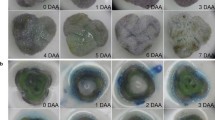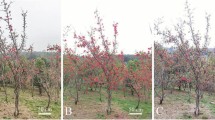Abstract
To obtain crossing products, an efficient pollination and subsequent fertilization is essential. This efficient pollination is achieved by pollen germination and tube growth. Here, these pollen characteristics of 2 genetically differentiating cultivars of Anemone coronaria L. were investigated in vitro. For the essential components boron, calcium and an osmoticant, only calcium showed to be crucial for pollen germination. Boron concentrations influenced the pollen tube length with a concentration of 100 mg l−1 H3BO3 resulting in the longest pollen tubes. For the osmoticant sucrose, a concentration of 100 g l−1 caused a significant positive effect on both pollen germination and pollen tube length for the 2 cultivars. The cultivars reacted similarly with respect to the investigated compounds. Next to this, the pollen development was correlated with 8 different flower stages in A. coronaria. As a final point, the germination of an optimized pollen germination medium was compared with in vivo pollen germination in cross-pollinations within the same cultivar (identified by aniline blue staining). For ‘Mistral Wine’, pollen germination percentage was lower in vitro than in vivo, while ‘Wicabri Blue’ pollen showed no significant difference in germination rates in vivo and in vitro. To achieve fertilization a following requisite is that the stigma is receptive. To study this, the most receptive female flower stage of the 8 different flower stages for A. coronaria was characterized by aniline blue staining. A. coronaria clearly showed protogyny.





Similar content being viewed by others
References
Ari E, Buyukalaca S, Eti S, Gok P (2005) Some cytological observations on pollen grains of wild poppy Anemone variaties from Turkey. Acta Hortic 673:699–703
Brewbaker JL, Kwack BH (1963) Essential role of calcium ion in pollen germination and pollen tube growth. Am J Bot 50(9):859–865
Calic D, Radojevic LJ (2017) Horse chestnut pollen quality. Genetika 49(1):105–115
Candan F, Cani IO (2015) Studies on the comparison of pollen morphology and viability of four naturally distributed and commercial varieties of Anemone coronaria L. Pak J Bot 47(2):517–522
Cox RM (1983) Sensitivity of forest plant reproduction to long range transported air pollutants: in vitro sensitivity of pollen to simulated acid rain. New Phytol 95:269–276
Dhooghe E, Grunewald W, Reheul D, Goetghebeur P, Van Labeke M-C (2012) Floral characteristics and gametophyte development of Anemone coronaria L. and Ranunculus asiaticus L. (Ranunculaceae). Sci Hortic 138:73–80
Dumont-Béboux N, Anholt B, von Aderkas P (1999) In vitro Douglas fir pollen germination: influence of hydration, sucrose and polyethylene glycol. Ann For Sci 56:11–18
Edlund AF, Swanson R, Preuss D (2004) Pollen and stigma structure and function: the role of diversity in pollination. Plant Cell 16:S84–S97
Fan LM, Wang YF, Wang H, Wu WH (2001) In vitro Arabidopsis pollen germination and characterization of the inward potassium currents in Arabidopsis pollen grain protoplasts. J Exp Bot 52:1603–1614
Fei S, Nelson E (2003) Estimation of pollen viability, shedding pattern, and longevity of creeping bentgrass on artificial media. Crop Sci 43(6):2177–2181
Heslop-Harrison JS (1992) Cytological techniques to assess pollen quality. In: Cresti M, Tiezzi A (eds) Sexual plant reproduction. Springer, Berlin, pp 41–48
Heslop-Harrison Y, Shivanna KR (1977) The receptive surface of the angiosperm stigma. Ann Bot 41:1233–1258
Holdaway-Clarke TL, Hepler PK (2003) Control of pollen tube growth: role of ion gradients and fluxes. New Phytol 159:539–563
Hoot SB, Reznicek A (1994) Phylogenetic relationships in Anemone (Ranunculaceae) based on morphology and chloroplast DNA. Syst Bot 19:169–200
Horovitz A (1991) The pollination syndrome of Anemone coronaria L.; an insect-biased mutualism. Acta Hortic 288:283–287
Koncalova MN, Jicinska D, Sykorova O (1976) Effect of calcium and sucrose concentration on pollen germination in vitro of six Rosa species. Biol Plant 18:26–30
Laura M, Allavena A (2007) Anemone coronaria breeding: current status and perspectives. Eur J Hortic Sci 72:241–247
Laura M, Allavena A, Magurno F, Lanteri S, Portis E (2006a) Genetic variation of commercial Anemone coronaria cultivars assessed by AFLP. J Hortic Sci Biotechnol 81(4):621–626
Laura M, Safaverdi G, Allavena A (2006b) Androgenetic plants of Anemone coronaria derived through anther culture. Plant Breed 125:629–634
Muccifora S, Bellani LM, Gori P (2003) Ultrastructure, viability and in vitro germination of the tricellular Sambucus nigra L. pollen. Int J Plant Sci 164:855–860
Mulcahy GB, Mulcahy DL (1988) The effect of supplemented media on the growth in vitro of bi- and trinucleate pollen. Plant Sci 55:213–216
Nepi M, Franchi GG (2000) Cytochemistry of mature angiosperm pollen. Plant Syst Evol 222:45–62
Niimi Y, Shiokawa Y (1992) A study on the storage of Lilium pollen. J Jpn Soc Hortic Sci 61(2):399–403
Pareddy DR, Petolino JF (1992) Maturation of maize pollen in vitro. Plant Cell Rep 11(10):535–539
Parton E, Vervaeke I, Delen R, Vandenbussche B, Deroose R, De Proft M (2002) Viability and storage of bromeliad pollen. Euphytica 125(2):155–161
Read SM, Clarke AE, Bacic A (1993) Stimulation of growth of cultured Nicotiana tabacum W38 pollen tubes by poly(ethylene glycol) and Cu(II) salts. Protoplasma 177:1–14
Rihova L, Hrabetova E, Tupy J (1996) Optimization of conditions for in vitro pollen germination and tube growth in potatoes. Int J Plant Sci 157:561–566
Shivanna KR, Linskens HF, Cresti M (1991) Pollen viability and pollen vigor. Theor Appl Genet 81(1):38–42
Tamura M (1995) Reproductive structures. In: Engler A, Prantl K (eds) Die Natürlichen Pflanzenfamilien. Bd. 17 a IV Angiospermae. Ordnung Ranunculales. Fam. Ranunculaceae, 2nd edn. Duncker and Humblot, Berlin, pp 41–76
Taylor LP, Hepler PK (1997) Pollen germination and tube growth. Ann Rev Plant Physiol Plant Mol Biol 48:461–491
Tian HQ, Russell SD (1997) Micromanipulation of male and female gametes of Nicotiana tabacum.1. Isolation of gametes. Plant Cell Rep 16(8):555–560
Tupy J, Rihova L (1984) Changes and growth effect of pH in pollen-tube culture. J Plant Physiol 115(1):1–10
Tupy J, Hrabetova E, Capkova V (1983) Amino-acids and bivalent-cations in the growth of tobacco pollen in mass-culture. Plant Sci Lett 30(1):91–98
Vervaeke I, Delen R, Wouters J, Deroose R, De Proft MP (2004) Division of the generative nucleus in cultured pollen tubes of the Bromeliaceae. Plant Cell Tissue Organ 76:17–28
Vervaeke I, Londers E, Piot G, Deroose R, De Proft MP (2005) The division of the generative nucleus and the formation of callose plugs in pollen tubes of Aechmea fasciata (Bromeliaceae) cultured in vitro. Sex Plant Reprod 18(1):9–19
Wolukau JN, Zhang SL, Xu GH, Chen DX (2004) The effect of temperature, polyamines and polyamine synthesis inhibitor on in vitro pollen germination and pollen tube growth of Prunus mume. Sci Hortic 99(3–4):289–299
Zhan N, Huang L (2016) Effects of Ca2+ on in vitro pollen germination of three Acacia species. Silvae Genet 65(2):11–16
Zhang LX, Chang WC, Wei YJ, Liu L, Wang YP (1993) Cryopreservation of ginseng pollen. Hortsci 28(7):742–743
Acknowledgements
We thank IRF (Istituto Regionale per la Floricoltura, Sanremo, Italy) and Biancheri Creations (Camporosso Mare, Italy) for delivering high qualitative plant material.
Author information
Authors and Affiliations
Corresponding author
Rights and permissions
About this article
Cite this article
Dhooghe, E., Reheul, D., Versluys, T. et al. Pollen characteristics and stigma receptivity for Anemone coronaria L.. Euphytica 214, 211 (2018). https://doi.org/10.1007/s10681-018-2294-0
Received:
Accepted:
Published:
DOI: https://doi.org/10.1007/s10681-018-2294-0




